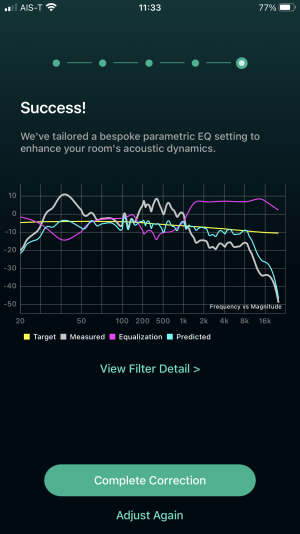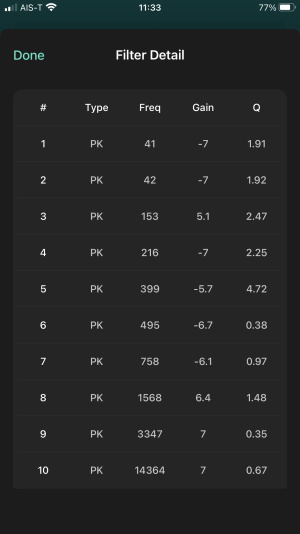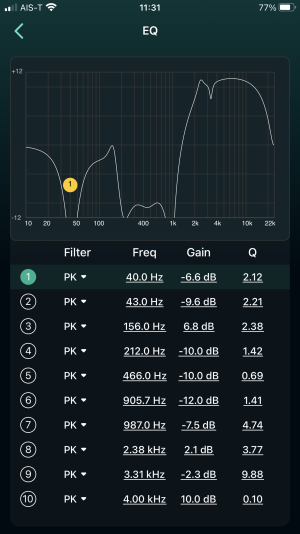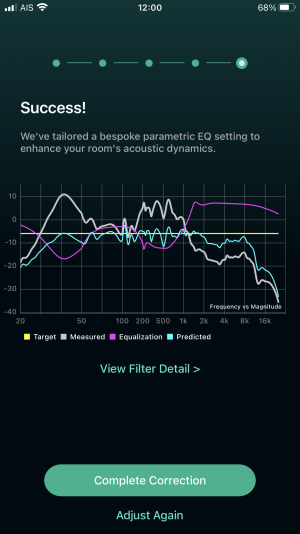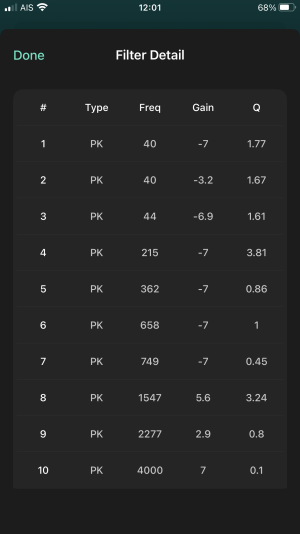You are using an out of date browser. It may not display this or other websites correctly.
You should upgrade or use an alternative browser.
You should upgrade or use an alternative browser.
How to use Room Correction?
- Thread starter MCG555
- Start date
Brantome
Major Contributor
- Joined
- Oct 20, 2022
- Messages
- 6,842
You can save the set of PEQ values generated by RC as a custom set for each position and load them as required.Is it possible to store and switch between different measurements/corrections ?
I usually have 2 places in the room where I need to apply correction. Depending on where I sit, I want to Switch
Here is my case. Since I use a subwoofer (another one is coming soon to make 2.2 system), I open the low end to 30Hz. I use iPhone 13 without case. RC tries to damp down low frequency - I don't see any null below 100Hz. I am more worried about a dip near ~150Hz. Do I hear anything different? Other the low end, I don't hear much difference.

Ok, more or less similar case like mine. I have already a 2.2 setup.
1. You can easily go down to 20Hz to do the corrections - works for me at least…
2. Your Sub seam to produce too much base, so WiiM tries to correct it… (your 3. chart)
3. What is the 4. chart about?
Ok, more or less similar case like mine. I have already a 2.2 setup.
1. You can easily go down to 20Hz to do the corrections - works for me at least…
2. Your Sub seam to produce too much base, so WiiM tries to correct it… (your 3. chart)
3. What is the 4. chart about?
I have 2 subwoofers (helps the mods).
Default curve is B&K.
I’m using the RC with my Marantz AVR and JBL 4313B monitors with excellent results. I tried all three curves and BK is the best for me. I realize the curve it comes up with is a bit confusing but the results have been really nice. Some one posted a site that explains how these curves work. Highly interesting!I have 2 subwoofers (helps the mods).
Default curve is B&K.
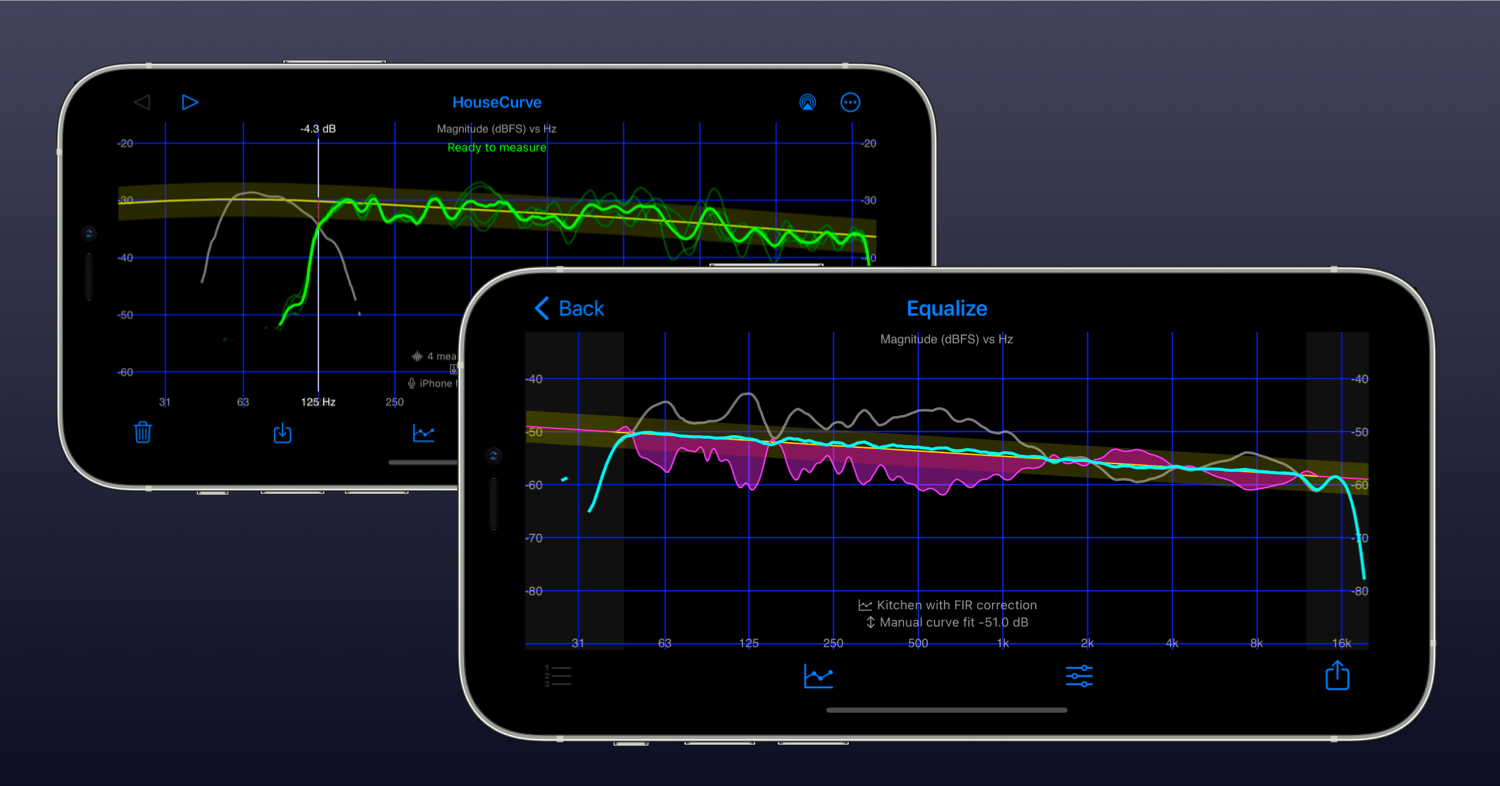
Target Curves
HouseCurve is an iOS app for tuning audio systems. Use it for room correction, adjusting equalizers, setting subwoofer phase, choosing crossovers and more.
 housecurve.com
housecurve.com
alpha_zulu
Senior Member
Do no compensate for dips in the bass response, you can overload your system. Dips (nulls) should never be corrected at low frequencies as these are down to standing waves in your room being out of phase with each other at that frequency and it results in cancellation.You should not attempt to combat nulls with RC at bass frequencies it will not work and in some cases create an even worse results. You should only be applying reductions in the bass region to the target curve. You also will need to reduce the overal volume of the device out to compensate for any gains above 0db or you will get clipping.
Start by only corrected from the range yout speakers roll off at and up to 200 or 300 hz the rooms shroeder frequencies as above this is frequencues less prone to room nodes and more to do with other factors and you start getting in to altering your speakers voicing not the room but nulls can be compensated higher up the freq range if required. Personally i dont correct above 500hz and even then would rather keep it lower.
If you want to try and elimiate nulls you need to reduce headroom significanlty that the curve is reducing stuff down to create a more flat response, this will mean you loose gain as in some cases can be adjusting the whole curve down -12 or more.
That's exactly the kind of advice I'm looking for. Unfortunately, I don't understand all of them because I don't have the specialised knowledge that would probably be necessary.
If I understand correctly, it is better to correct only a small range up to max. 500 Hz, because beyond that the room modes have less influence on the sound.
I think we should discuss such general principles in this thread rather than individual personal cases. Simply to get to know the new functions better and to understand what effects they have.
steadyshot
Major Contributor
- Joined
- Mar 14, 2023
- Messages
- 885
Above Schroeder you can correct for reflections up to the mid frequency. If the speaker has a smooth spinorama the corrections will be beneficial above Schroeder . For those of us without subs ( unlucky ones ) we need also a steep downward slope to make the sound more balanced and easy on our ears . I will try also Harman curve which is more bassy. However steep corrections above Schroeder can introduce serious phase distortion which is audible
alpha_zulu
Senior Member
What ist spinorama?
What ist spinorama?
Near-field measurement to simulate response in anechoic chamber
What is Schroeder?What ist spinorama?
alpha_zulu
Senior Member
What is Schroeder?

The Schroeder / Transition Frequency Explained
Brent Butterworth, a writer over at Sound & Vision, has written a very easy to understand explanation of what the 'Schroeder' frequency is. The Schroeder or 'transition' frequency is a critical concept to understand because it explains a lot about how sound behaves in rooms, how we measure /...
And here you can calculate it:

amroc - THE Room Mode Calculator
HTML5 room mode calculator. Read and hear the tune of axial, tangential and oblique modes. Scientific sources included.
alpha_zulu
Senior Member
This is also an informative article:

 housecurve.com
housecurve.com

Equalization
HouseCurve is an iOS app for tuning audio systems. Use it for room correction, adjusting equalizers, setting subwoofer phase, choosing crossovers and more.
 housecurve.com
housecurve.com

The Schroeder / Transition Frequency Explained
Brent Butterworth, a writer over at Sound & Vision, has written a very easy to understand explanation of what the 'Schroeder' frequency is. The Schroeder or 'transition' frequency is a critical concept to understand because it explains a lot about how sound behaves in rooms, how we measure /...acousticfrontiers.com
And here you can calculate it:

amroc - THE Room Mode Calculator
HTML5 room mode calculator. Read and hear the tune of axial, tangential and oblique modes. Scientific sources included.amcoustics.com
Thank you!
Yeah, I trust mostly my ears in this regard - also why I added a 2. Sub years ago, you can soften / avoid some room problems / mods. At the end there are always compromises…
What I like in respect to this RC from WiiM - it gives you more data, what you really hear in your room with your loudspeakers at a given place. It‘s up to you, if you leave the values like they come from RC or if you adapt them in the sense, you want it or adapt it so that other places in your room sound also better…
Meanwhile it works for me well!
Although I don’t have a Pro, I have the WiiM Amp but was not part of Beta i am using RC using Housecurve, one learning that worked for me as I have a Sub is to actually Time Align sub and mains at crossover before taking RC measurements, as others have mentioned the RC is often impactful below Schroeder
And how do you do time alignment?Although I don’t have a Pro, I have the WiiM Amp but was not part of Beta i am using RC using Housecurve, one learning that worked for me as I have a Sub is to actually Time Align sub and mains at crossover before taking RC measurements, as others have mentioned the RC is often impactful below Schroeder
Yanto
Active member
- Joined
- Jul 27, 2023
- Messages
- 163
Just installed the update with Room Correction. Followed the instructions, got the test signals and completed the equalisation. Used my iPhone 7 Plus.
It sounds awful! Thin, lacking body, way too trebly too. I’ll try to add screenshots.
Any help would be great please. Thanks
It sounds awful! Thin, lacking body, way too trebly too. I’ll try to add screenshots.
Any help would be great please. Thanks
Attachments
Set your curve on flat and range from 40 to 4khz. Run it again. Make sure reset the current eq.Just installed the update with Room Correction. Followed the instructions, got the test signals and completed the equalisation. Used my iPhone 7 Plus.
It sounds awful! Thin, lacking body, way too trebly too. I’ll try to add screenshots.
Any help would be great please. Thanks
Yanto
Active member
- Joined
- Jul 27, 2023
- Messages
- 163
Thanks. Sounds exactly the same as before. Awful!Set your curve on flat and range from 40 to 4khz. Run it again. Make sure reset the current eq.
Attachments
Did you reset eq prior running RC? Did you point the iPhone mic in between the speaker on ear level?Thanks. Sounds exactly the same as before. Awful!
Yanto
Active member
- Joined
- Jul 27, 2023
- Messages
- 163
I think I must be doing something wrong. This is much worse than just using normal eq.I used to be beta on RC and during that time it was bad on their second update. However, the official RC corrected what I was complaining and now sounds great. Thanks wiim!
Similar threads
- Suggestion
- Replies
- 2
- Views
- 368
- Question
- Replies
- 11
- Views
- 1K
- Replies
- 4
- Views
- 754
- Replies
- 4
- Views
- 531
- Replies
- 9
- Views
- 943

